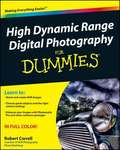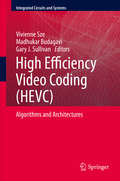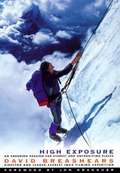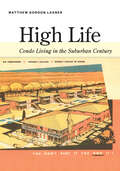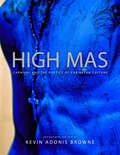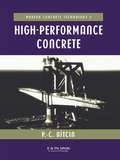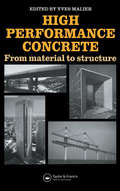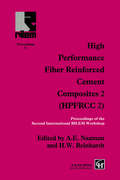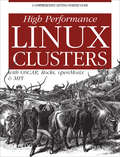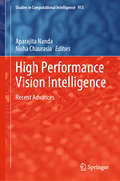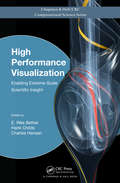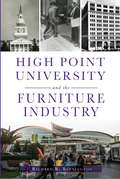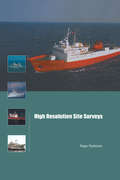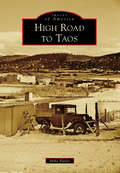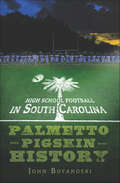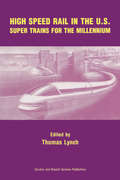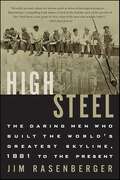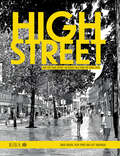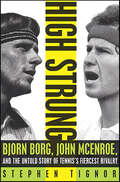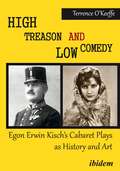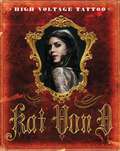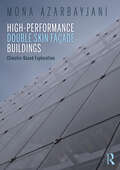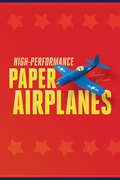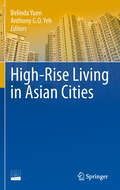- Table View
- List View
High Dynamic Range Digital Photography For Dummies
by Robert CorrellCreate amazing HDR photos with this full-color, plain-English guide Your secret is safe with us. Even if you don't have the latest high-end high dynamic range (HDR) camera equipment, you can still create striking images that appear as if you do with the tips, tricks, and techniques in this helpful guide. Discover how to use bracketing effectively, get the most out of a tripod, finesse your photos with Photoshop, and make it all go easier with this practical and inspiring book. Shines a light on HDR-what it is, how it's done, and what tools you need Walks you through how to take good photographs, from using the right settings to choosing good HDR subjects Demonstrates how to put all your images together in a single photo, including selecting the software, establishing workflow, and creating files Covers how you can clean up digital residue, how to create HDR in black and white, and much more Packed with beautiful and inspiring full-color HDR images to fire your imagination Get fresh ideas, avoid mistakes, and produce memorable images with this essential guide.
High Efficiency Video Coding (HEVC)
by Vivienne Sze Madhukar Budagavi Gary J. SullivanThis book provides developers, engineers, researchers and students with detailed knowledge about the High Efficiency Video Coding (HEVC) standard. HEVC is the successor to the widely successful H. 264/AVC video compression standard, and it provides around twice as much compression as H. 264/AVC for the same level of quality. The applications for HEVC will not only cover the space of the well-known current uses and capabilities of digital video - they will also include the deployment of new services and the delivery of enhanced video quality, such as ultra-high-definition television (UHDTV) and video with higher dynamic range, wider range of representable color, and greater representation precision than what is typically found today. HEVC is the next major generation of video coding design - a flexible, reliable and robust solution that will support the next decade of video applications and ease the burden of video on world-wide network traffic. This book provides a detailed explanation of the various parts of the standard, insight into how it was developed, and in-depth discussion of algorithms and architectures for its implementation.
High Exposure: An Enduring Passion for Everest and Unforgiving Places
by Jon Krakauer David F. BreashearsFor generations of resolute adventurers, from George Mallory to Sir Edmund Hillary, Tenzing Norgay to Jon Krakauer, Mount Everest and the world's greatest peaks have provided the ultimate testing ground. As the world's fascination with mountaineering reaches a fever pitch, the question remains: Why climb? In High Exposure, elite mountaineer and acclaimed filmmaker David Breashears answers with an intimate and captivating look at his life. Breashears's passion for climbing began on the cliffs of Boulder, Colorado--and nearly ended on the south side of Everest in 1996.
High Life: Condo Living in the Suburban Century
by Matthew LasnerThe first comprehensive architectural and cultural history of condominium and cooperative housing in twentieth-century America. Today, one in five homeowners in American cities and suburbs lives in a multifamily home rather than a single-family house. As the American dream evolves, precipitated by rising real estate prices and a renewed interest in urban living, many predict that condos will become the predominant form of housing in the twenty-first century. In this unprecedented study, Matthew Gordon Lasner explores the history of co-owned multifamily housing in the United States, from New York City’s first co-op, in 1881, to contemporary condominium and townhouse complexes coast to coast. Lasner explains the complicated social, economic, and political factors that have increased demand for this way of living, situating the trend within the larger housing market and broad shifts in residential architecture and family life. He contrasts the prevalence and popularity of condos, townhouses, and other privately governed communities with their ambiguous economic, legal, and social standing, as well as their striking absence from urban and architectural history.
High Mas: Carnival and the Poetics of Caribbean Culture
by Kevin Adonis BrowneOverall Winner of the 2019 OCM Bocas Prize for Caribbean LiteratureHigh Mas: Carnival and the Poetics of Caribbean Culture explores Caribbean identity through photography, criticism, and personal narrative. Taking a sophisticated and unapologetically subjective Caribbean point of view, the author delves into Mas—a key feature of Trinidad performance—as an emancipatory practice. The photographs and essays here immerse the viewer in carnival experience as never before. Kevin Adonis Browne divulges how performers are or wish to be perceived, along with how, as the photographer, he is implicated in that dynamic. The resulting interplay encourages an informed, nuanced approach to the imaging of contemporary Caribbeanness. The first series, “Seeing Blue,” features Blue Devils from the village of Paramin, whose performances signify an important revision of the post-emancipation tradition of Jab Molassie (Molasses Devil) in Trinidad. The second series, “La Femme des Revenants,” chronicles the debut performance of Tracey Sankar’s La Diablesse, which reintroduced the “Caribbean femme fatale” to a new audience. The third series, “Moko Jumbies of the South,” looks at Stephanie Kanhai and Jonadiah Gonzales, a pair of stilt-walkers from the performance group Touch de Sky from San Fernando in southern Trinidad. “Jouvay Reprised,” the fourth series, follows the political activist group Jouvay Ayiti performing a Mas in the streets of Port of Spain on Emancipation Day in 2015. Troubling the borders that persist between performer and audience, embodiment and spirituality, culture and self-consciousness, the book interrogates what audiences understand about the role of the participant-observer in public contexts. Representing the uneasy embrace of tradition in Trinidad and the Caribbean at large, the book probes the multiple dimensions of vernacular experience and their complementary cultural expressions. For Browne, Mas performance is an exquisite refusal to fully submit to the lingering traumas of slavery, the tyrannies of colonialism, and the myths of independence.
High Performance Concrete
by Pierre-Claude AïtcinA complete review of the fast-developing topic of high performance concrete (HPC) by one of the leading researchers in the field. It covers all aspects of HPC from materials, properties and technology, to construction and testing. The book will be valuable for all concrete technologists and construction engineers wishing to take advantage of the re
High Performance Concrete: From material to structure
by Yves MalierProvides a thorough review of properties, durability and use of high performance concrete, derived from recent research and experience. This book contains contributions from the leading French, Canadian and Swiss researchers, designers and material specialists, translated into English for the first time.
High Performance Fiber Reinforced Cement Composites 2: Proceedings of the International Workshop
by H. W. Reinhardt A. E. NaamanThe leading international authorities bring together in this contributed volume the latest research and current thinking on advanced fiber reinforced cement composites. Under rigorous editorial control, 13 chapters map out the key properties and behaviour of these materials, which promise to extend their applications into many more areas in the com
High Performance Linux Clusters with OSCAR, Rocks, OpenMosix, and MPI: A Comprehensive Getting-Started Guide
by Joseph D SloanTo the outside world, a "supercomputer" appears to be a single system. In fact, it's a cluster of computers that share a local area network and have the ability to work together on a single problem as a team. Many businesses used to consider supercomputing beyond the reach of their budgets, but new Linux applications have made high-performance clusters more affordable than ever. These days, the promise of low-cost supercomputing is one of the main reasons many businesses choose Linux over other operating systems.This new guide covers everything a newcomer to clustering will need to plan, build, and deploy a high-performance Linux cluster. The book focuses on clustering for high-performance computation, although much of its information also applies to clustering for high-availability (failover and disaster recovery). The book discusses the key tools you'll need to get started, including good practices to use while exploring the tools and growing a system. You'll learn about planning, hardware choices, bulk installation of Linux on multiple systems, and other basic considerations. Then, you'll learn about software options that can save you hours--or even weeks--of deployment time.Since a wide variety of options exist in each area of clustering software, the author discusses the pros and cons of the major free software projects and chooses those that are most likely to be helpful to new cluster administrators and programmers. A few of the projects introduced in the book include:MPI, the most popular programming library for clusters. This book offers simple but realistic introductory examples along with some pointers for advanced use.OSCAR and Rocks, two comprehensive installation and administrative systemsopenMosix (a convenient tool for distributing jobs), Linux kernel extensions that migrate processes transparently for load balancingPVFS, one of the parallel filesystems that make clustering I/O easierC3, a set of commands for administering multiple systemsGanglia, OpenPBS, and cloning tools (Kickstart, SIS and G4U) are also covered. The book looks at cluster installation packages (OSCAR & Rocks) and then considers the core packages individually for greater depth or for folks wishing to do a custom installation. Guidelines for debugging, profiling, performance tuning, and managing jobs from multiple users round out this immensely useful book.
High Performance Vision Intelligence: Recent Advances (Studies in Computational Intelligence #913)
by Aparajita Nanda Nisha ChaurasiaThis book focuses on the challenges and the recent findings in vision intelligence incorporating high performance computing applications. The contents provide in-depth discussions on a range of emerging multidisciplinary topics like computer vision, image processing, artificial intelligence, machine learning, cloud computing, IoT, and big data. The book also includes illustrations of algorithms, architecture, applications, software systems, and data analytics within the scope of the discussed topics. This book will help students, researchers, and technology professionals discover latest trends in the fields of computer vision and artificial intelligence.
High Performance Visualization: Enabling Extreme-Scale Scientific Insight (Chapman & Hall/CRC Computational Science)
by Hank Childs E. Wes Bethel Charles HansenVisualization and analysis tools, techniques, and algorithms have undergone a rapid evolution in recent decades to accommodate explosive growth in data size and complexity and to exploit emerging multi- and many-core computational platforms. High Performance Visualization: Enabling Extreme-Scale Scientific Insight focuses on the subset of scientifi
High Point University and the Furniture Industry
by Richard R. BenningtonHigh Point University was founded in 1924 as a small liberal arts college. The High Point Furniture Market was founded in 1909 and has grown to be the largest wholesale furniture market in the world. Over the past century, the furniture industry and the university have developed an ongoing, mutually beneficial partnership that has resulted in industry-specific programs for students. Discover the history of this relationship and the impact that real-world exposure has had on the students and the industry. Read the stories of several High Point University graduates who are successfully employed in various positions throughout the furniture business. High Point professor Richard Bennington unearths the history of a dynamic partnership.
High Resolution Site Surveys
by Roger ParkinsonHigh Resolution Site Surveys brings together the full range of site surveying techniques for the first time, to provide a unified approach to marine and land-based resolution surveying.Detailed descriptions are given of digital seismic survey methods, hydrographic 'analogue' search and survey tools, non-seismic survey techniques, and positioning sy
High Road to Taos (Images of America)
by Mike ButlerThe High Road to Taos, listed in the New Mexico Register of Cultural Properties in 1975, covers 52 miles from just north of Santa Fe to Ranchos de Taos at the southern boundary of the town of Taos. In addition to spectacular mountain scenery, the High Road contains Pueblo Indian settlements dating back to the 1300s and Hispanic settlements dating back to the 1600s. Historic adobe Catholic churches can be seen in each village, with the church at Las Trampas having been constructed in 1760. Today, artist communities have grown in and around the villages. Photographers from the federal Farm Security Administration extensively photographed the villages along the High Road in the 1930s and 1940s. These photographs provide an exceptional record of Hispanic village life in northern New Mexico and will be of interest to travelers along the High Road as a basis of comparison to what they are viewing today.
High School Football in South Carolina: Palmetto Pigskin History (Sports)
by John BoyanoskiSouth Carolina has a proud tradition of high school football stretching back to the 1890s, making the sport one of the most celebrated in the state. Discover how Florence High School-- sometimes dubbed the Yellow Jackets or the Golden Tornados--won the first four state titles, a record that has been tied but never broken. And learn about the aftermath of a 1922 game between Columbia and Charleston, when violent Columbia fans hurled eggs at the Charleston train as the players left for home. Through the 1960s, the sport withstood the immense pressure of integration until 157 teams ballooned into 193 by the end of the decade. John Boyanoski reveals the trophies, tears, and triumphs of the Palmetto State's time-honored football legacy.
High Speed Rail in the US: Super Trains for the Millennium
by Thomas LynchAn original approach for dealing with High Speed Rail (HSR) transportation development in the United States, this book serves as a blueprint for such development by providing an in-depth evaluation of the different systems and their inherent linkage to other transportation modes, their potential costs, financing options, system benefits, the curren
High Steel: The Daring Men Who Built the World's Greatest Skyline, 1881 to the Present
by Jim RasenbergerA powerful first-hand account of the many generations and ethnic groups of men who have built America's skyscrapers.From the early days of steel construction in Chicago, through the great boom years of New York city ironwork, and up through the present, High Steel follows the trajectory of careers inextricably linked to both great accomplishment and catastrophic disaster. The personal stories reveal the lives of ironworkers and the dangers they face as they walk across the windswept, swaying summits of tomorrow's skyscrapers, balanced on steel girders sometimes only six inches wide. Rasenberger explores both the greatest accomplishments of ironwork—the vaulting bridges and towers that define America's skyline—and the deadliest disasters, such as the Quebec Bridge Collapse of 1907, when 75 ironworkers, including 33 Mohawk Indians, fell to their deaths. High Steel is an accessible, thrilling, and vertiginous portrait of the lives of some of our most brave yet unrecognized men.
High Street: How our town centres can bounce back from the retail crisis
by David Rudlin Vicky Payne Lucy MontagueThe high street is in crisis. How did we get here and what happens next? The global pandemic has made the crisis immeasurably worse but it wasn’t the cause. The crisis was already raging in 2019 with thousands of store closures. Large retailers became complacent and failed to respond to changing consumer behaviour. Town centres are the victims of these changes rather than the cause of them. To understand the current crisis and how it might be addressed, this book takes a long view of retailing based on a hundred case studies. It looks at the way town centres responded to previous crises and explores current trends affecting town centres and how places are responding. The message is optimistic: adaptable town centres can once more become the diverse, characterful, independent places that existed before they were homogenised by big retail. Explore the past – understand the present – find a better future.
High Strung: Bjorn Borg, John McEnroe, and the Untold Story of Tennis's Fiercest Rivalry
by Stephen Tignor“A book full of aces....A true page-turner.”—Associated Press“This is good stuff, and it’s written with flair.”—The OregonianHigh Strung by Stephen Tignor is the gripping untold story of the fiercest rivalry in the history of professional tennis. Viewed through the lens of the fabled 1981 U.S. Open match between Bjorn Borg and John McEnroe, High Strung brings the golden age of tennis vibrantly alive once more. A fascinating chronicle that orbits around the four greatest, most enigmatic talents in the sport at the time—McEnroe, Borg, Jimmy Connors, and Vitas Gerulaitis—High Strung is a superior sports history, a must read for anyone who truly loves the game.
High Treason and Low Comedy: Egon Erwin Kisch’s Cabaret Plays as History and Art
by Robert T. O’KeeffeHigh Treason and Low Comedy is the first in-depth treatment in English of E. E. Kisch’s work as a playwright, a phase of his life to which he devoted considerable effort during the years 1920–1925.The translations of his two most successful works for the cabaret stages of Germany, Austria, and Czechoslovakia form the basis of discussions that fit them into several intersecting streams: biographical, historical, and cultural. The plays are Die Hetzjagd, which describes the last day on earth of the infamous traitor, Colonel Alfred Redl, and Die Himmelfahrt der Tonka Šibenice (Galgentoni), which presents the comical, coarse, and, at times, pathetic efforts of a Prague prostitute to argue her way into heaven. The plays are a portal into the world of Kisch’s youth as an enterprising journalist and into his thinking and writing just before he became “the raging reporter” and the star of international reportage. While they reflect the Prague milieu of his youth during the twilight years of the Austro-Hungarian Empire, they also illustrate Kisch’s lifelong critical attitude toward the conservative authorities of society, their derelictions of duty, and their indifference to the welfare of the common man and woman.The book also examines the long afterlife of both of these stories as they were re-created by artists in stage, film, novelistic, and television adaptations, illustrating the theme of what happens when historical materials are transformed into art.
High Voltage Tattoo FF
by Kat Von DHigh Voltage Tattoo is a graphic perspective on today's global tattoo culture by Kat Von D, star of The Learning Channel's L.A. Ink and one of the most talented and popular artists working today. Designed in a style that is reminiscent of a handmade Gothic journal with its red padded cover, ornate typography, and parchmentlike pages, it throws the door wide open to tattooing culture in the way only an insider like Kat can.High Voltage Tattoo traces Kat's career as an artist, from early childhood influences to recent work, along with examples of what inspires her, information about the show and her shop, her sketches, and personal tattoos. The book goes deep into tattoo process and culture: readers can see up close the pigments, the tools, and the making of complex, even collaborative, tattoos.With a foreword by Mötley Crüe's Nikki Sixx, the book features images and stories about celebrities, rockers, pro skaters, and everyday citizens, including Slayer's Kerry King, Anthrax's Scott Ian, Margaret Cho, Jackass' Bam Margera, David Letterman, and many others. It profiles and showcases the work of artists Kat has selected from all over the world, her interviews with people who have compelling tattoos and stories, and amazing images of extraordinary tattoo work. Numerous portfolios throughout the book showcase a range of relevant subjects, from the black and gray portrait work for which Kat is famous to a popular tattoo theme, such as the rose or biblical images. There is a knockout ten-page full-body spread of Kat—clad in a yellow bikini and seven-inch, rhinestone-studded red stilettos—that catalogs in detail all her personal tattoos on her front, back, left, and right sides—even her hands and head.
High-Performance Double Skin Façade Buildings: Climatic-Based Exploration
by Mona AzarbayjaniThis book provides a comprehensive theoretical platform for the use and construction of double skin façade projects. The DSF concept has been used mostly in European buildings; however, its success in other climates should be addressed. Increasing numbers of buildings are featuring double skin façade technology in the US; however, still relatively few have been studied for their performance in operation. This book gives architects a practical guide to analyze and evaluate the actual performance of double skin façade buildings in different climatic contexts. It is important for high-performance buildings to have tools to evaluate a design’s predicted performance to achieve specific sustainable goals. To determine that the application of DSF in different climates will provide better thermal comfort, building simulation tools analyze various thermal comfort parameters through studies of the façade and compare them with the actual building’s performance data. The book takes the reader on an on-site tour of eight DSF buildings around the US. Interviews with the buildings’ architects and engineers, owners, and users offer additional perspectives and insights into the construction and performance of these developments in building design. This will provide architects with a comprehensive understanding of the challenges and opportunities in integrating double skin façades into their projects.
High-Performance Double Skin Façade Buildings: Climatic-Based Exploration
by Mona AzarbayjaniThis book provides a comprehensive theoretical platform for the use and construction of double skin façade projects. The DSF concept has been used mostly in European buildings; however, its success in other climates should be addressed. Increasing numbers of buildings are featuring double skin façade technology in the US; however, still relatively few have been studied for their performance in operation.This book gives architects a practical guide to analyze and evaluate the actual performance of double skin façade buildings in different climatic contexts. It is important for high-performance buildings to have tools to evaluate a design’s predicted performance to achieve specific sustainable goals. To determine that the application of DSF in different climates will provide better thermal comfort, building simulation tools analyze various thermal comfort parameters through studies of the façade and compare them with the actual building’s performance data. The book takes the reader on an on-site tour of eight DSF buildings around the US. Interviews with the buildings’ architects and engineers, owners, and users offer additional perspectives and insights into the construction and performance of these developments in building design.This will provide architects with a comprehensive understanding of the challenges and opportunities in integrating double skin façades into their projects.
High-Performance Paper Airplanes
by Andrew DewarFold and fire aerodynamic paper airplanes dozens of feet into the air with this easy origami ebook.High Performance Paper Airplanes presents a collection of realistic origami paper airplanes from well-known author and paper aviation expert Andrew Dewar. Dewar has spent decades perfecting the art of folding easy paper airplanes that both look great and fly well. This new series takes paper airplanes to new heights-literally! The planes can be fired high into the air with a rubber band launcher and are designed to circle down for a long time. The airplane designs are also printed in full-color on both sides and precut so you just need to push them out and assemble them using a bit of glue. Although fun for folders of any age, these paper plane designs are so simple that they can be considered "origami-for-kids" projects and are a great way to learn origami.The origami airplanes range from simple designs that can be assembled in under a minute to detailed scale replicas that look and fly like the real thing. The included instructional origami book not only explains how to assemble each plane, but how to fine-tune it to coax the best performance. Helpful tips for hosting competitions with your friends, and suggestions for designing your own origami airplane models are also included.This paper airplanes ebook contains: 46 page, full-color origami book Clear step-by-step instructionsTips on building and flying paper planes 10 paper airplane models Colorful and realistic designsFun to build and amazing to fly, these beautiful models are guaranteed to turn heads and draw a crowd of spectators every time you fly them. Using the rubber-band catapult and with a bit of practice, you'll be able to launch paper planes that remain aloft for 30 to 60 seconds-and more!Paper airplane models include:Hornet Tiger Eclipse Zero Corsair And many more...
High-Rise Living in Asian Cities
by Anthony G.O. Yeh Belinda YuenThis book is intended to fill a knowledge gap in the study of contemporary high-rise living. While there has been much documentation on the engineering and technological aspects of tall buildings, relatively little has been written about the social and livability of high-rise. Much less is written about Asian cities even though Asia is the current hotbed of high-rise development. Even though traditional discourse of high-rise housing is not always positive, new forces are redefining its place in 21st century urbanity. Many cities around the world are reembracing high-rise in urban agenda under current narrative of sustainable development. High-rise is fast becoming a priority area in international research agenda. The quest is for livable and sustainable high-rise development. Against the background of current trends--globalization, urbanization, mixed-use development, and new-built taller buildings in inner city areas in both developed and developing countries, this book examines the software: design, economics, estate management, legal and property rights, physical environment, planning, community development, and social dimensions of high-rise living. Analysis is with the widely acclaimed successful high-rise public housing in Hong Kong and Singapore to understand the advantages and worries of high-rise living, and to distill the key points and lessons in the making of a 'good' highrise living environment. Hong Kong and Singapore have been constructing high-rise for more than four decades each. The majority of their population has moved to live in high-rise, selecting to live high-rise, and registering consistently high residential satisfaction. The height of apartment buildings in both cities continues to rise. The tallest is anticipated to be 70-storey. It is the contention of this book that contrary to earlier common negative discourses on public high-rise living, the high-rise environment may yet offer urban residents a satisfying dwelling experience. Leading housing academics, researchers and practitioners in the two cities have contributed to this book. This book presents a timely contribution to our understanding of a widening urban phenomenon that will affect a growing number of the world's population.
